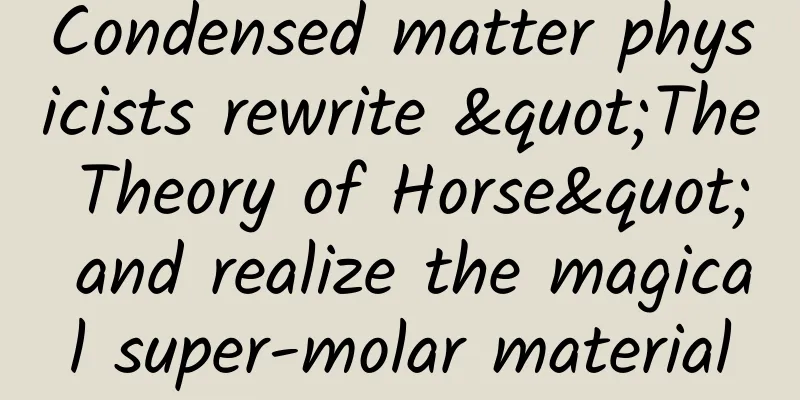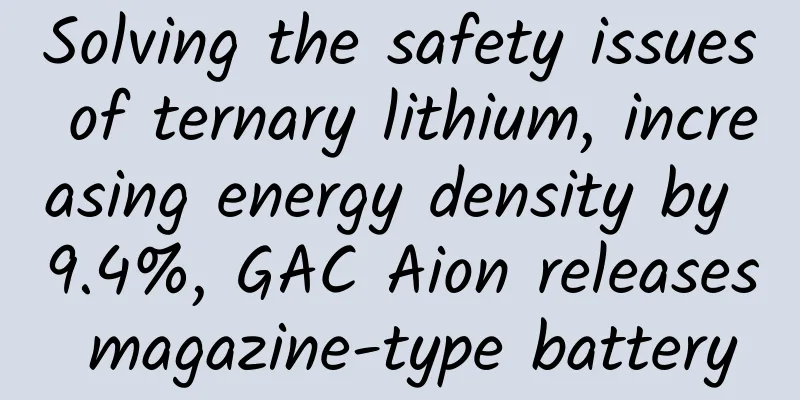Condensed matter physicists rewrite "The Theory of Horse" and realize the magical super-molar material

|
In the field of condensed matter physics, the research on quantum moiré materials is timely. This article will start with a physics version of "Ma Shuo" in the hope that readers can appreciate the new progress in this field: obtaining super-moiré materials with larger lattice lengths. We will appreciate the magical physical effects brought by super-moiré materials, and how the research completes the complete closed loop from theory to calculation to experiment, realizing integer flux Bloch states and integer BZ oscillations that have been pioneered but not achieved by previous researchers, and get a glimpse of how it opens up a new path for the study of the quantum world. Written by | Ma Yaqi (Hong Kong University of Science and Technology) , Huang Meizhen (Hong Kong University of Science and Technology) , Carlo and Wang Ning (Hong Kong University of Science and Technology) Super-moiré says There was moiré in the world, and then there was super-moiré. Moiré is common, but super-moiré is rare. The unit cell of Moiré's super can reach a scale of hundreds of nanometers, but the previous authors did not know that it could be possible to produce super. This is super-moiré, which is caused by the quantum interference effect of conventional moiré and the force of wave-particle duality. The amount of magnetic flux contained in a primitive cell of 100 nanometers increases a hundredfold, and the phenomenon that Brown-Zak oscillation is proportional to the magnetic field is obvious to the world. Alas! If Brown-Zak, Hou Shida and other predecessors could see today's data, they would surely say, "If it were not for this man, who would I go home with?" Solution This paragraph mixes Han Yu, Fan Zhongyan, and several physicists' "Super-moiré Theory", which may be confusing for everyone to read. I apologize in advance. However, this mixture of classical and vernacular Chinese, ancient and modern, Chinese and foreign, actually contains the new progress of current quantum moiré material research [1]. The following article can be read as an appreciation of this progress, just like the ancient Chinese literature you learned in middle school. Quantum moiré materials refer to artificial two-dimensional superlattice materials. Theoretical, computational and experimental research on such materials is currently the focus of condensed matter physics and quantum materials science. Specific examples include double-layer twisted graphene [2] and transition metal dichalcogenides. Superconductivity was discovered in the former, while the fractional Chern insulator, which is currently in full swing worldwide and is a magnetic field-free version of the fractional quantum Hall effect, was discovered in the latter. A common feature of these materials is that, through stacking and rotation, the scale of the artificial moiré lattice formed in the material can be larger than the scale of the atomic lattice in its single-layer component. For example, the honeycomb lattice formed by carbon atoms in a single-layer graphene has a bond length of the order of angstroms (10^(-10) m), while the moiré superlattice of double-layer twisted graphene can have a lattice length of the order of 10 nanometers (10^(-8) m). The novel phenomena that everyone pursues in quantum many-body physics and topological physics, such as two-dimensional (Dirac) electron gas, Mott insulators, non-Fermi liquids, unconventional superconductors, quantum anomalous Hall effect (Chen insulators) and its fractional version, etc., all emerge in quantum molar materials because of such changes in length scales and energy scales. Moreover, people can control them through precise gate voltage, rotation angle, strain, vertical electric field, external magnetic field, etc., to achieve phase transitions between these novel states of matter in the same sample. No wonder molar materials have become a hot topic in condensed matter physics, from theory to calculation to experiment, suitable for all ages. Can the changes in length scale and energy scale and the new physical phenomena that come with them continue to occur above the moiré? The progress we want to discuss here is to find a way to continue to increase the scale of the superlattice unit cell on the basis of the moiré superlattice, increasing the unit cell from 10 nanometers (10^(-8) m) to 100 nanometers (10^(-7) m). The two-dimensional superlattice material manufactured in this way is Super-moiré[1]. If you want to make the unit cell scale larger, it is not feasible to rely on artificially stacking two materials with similar lattice constants to form a heterojunction. The unit cell size of a heterojunction is determined by the lattice constant difference between the two layers of two-dimensional materials, and the difference is limited. For the most common heterojunction formed by graphene and hexagonal boron nitride (hBN), its maximum unit cell size is only ~14 nanometers. On the other hand, simply adjusting the angle between two layers of the same two-dimensional material in a homojunction cannot achieve a larger unit cell scale (although there have been many attempts before). This is because in actual materials, the unevenness of atomic arrangement is a big problem, and the double or multi-layers of moiré materials are connected by van der Waals forces (rather than chemical bonds commonly seen in three-dimensional materials). Van der Waals forces are not as strong as chemical bonds, and atoms can adjust their positions more easily to find the local ground state, but overall, this will make the atomic arrangement more chaotic and cannot form a periodic lattice. So how to overcome such a problem? As the old saying goes, "When in doubt, use quantum mechanics". The solution to the problem is to stack two already stable moiré superlattices and rotate them to the appropriate angle. When this happens, the wave function (wave-particle duality) of the electrons in the superimposed stable moiré superlattice (whose unit cell size is about 10 nanometers) will have an interference effect: if the relative rotation angle between the two moirés satisfies the commensurate condition required for interference, that is, when the reciprocal lattice vectors of the two sets of moirés satisfy a specific relationship, the wavelengths of the two moirés can interfere, and the waves produced by the interference can have a longer wavelength. The super-moiré superlattice produced in this way has a lattice length that can overcome the material inhomogeneity mentioned above and show a stable periodic lattice structure with larger unit cells. Because the formation of super-moiré relies on the quantum mechanical interference effect of the electron wave function in two stable moiré superlattices, rather than mechanically rotating the atomic density to simply arrange it geometrically in a larger period (not to mention that the atomic arrangement in actual materials is inherently uneven and the atomic density cannot really form a period), it is said that "the power of wave-particle duality has its reasons". The experimental results we have obtained so far are actually just one of the many interference wavelengths that meet the commensurability conditions in theory. It can be expected that once this path is opened, more super-moiré materials will be manufactured, and novel quantum many-body physics and topological physics phenomena on larger length scales will continue to emerge. So what new physical phenomena can we demonstrate with super-moiré of larger lattice length? This requires mentioning the several physicists "Brown-Zak, Hofstadter predecessors" embedded in the "Super-moiré Theory" in the introduction and the Hofstadter butterfly and Brown-Zak quantum oscillation effects demonstrated by the joint action of the periodic potential field and magnetic field of electrons in the lattice. Hofstadter's Butterfly and Brown-Zak Oscillations Hofstadter butterfly is not the butterfly effect often mentioned in chaos phenomena. Hofstadter is not Chinese, but American physicist DR Hofstadter (it must be said that his Chinese translation is very down-to-earth). In the 1970s, he obtained the energy spectrum of the quantum motion of electrons in a two-dimensional periodic potential field and a perpendicular magnetic field through numerical calculations. The spectrum is shaped like a butterfly, hence the name. His results also became one of the early examples of modern scientific computing data visualization [3]. Figure 1. The “butterfly diagram” drawn by Hofstadter describes the energy level of electrons in a two-dimensional square lattice as a function of the external magnetic field, shaped like a butterfly. The image is from reference [4]. The energy level of electrons in a two-dimensional square lattice as a function of the external magnetic field is shown in Figure 1. The most notable feature of this spectrum in terms of mathematical structure is that, under a specific magnetic field value (horizontal axis), the energy eigenstates (vertical axis) that electrons can be in can undergo complex splitting as the magnetic field changes, and produce an iterative fractal structure, shaped like a butterfly. Later, people discovered that the characteristic of butterfly wings is the Chern integer, so the Hofstadter butterfly played an important role in the subsequent integer quantum Hall effect theory and topological quantum number theory. The essential reason for the generation of such a pattern is that under the conditions of commensurate When the field is zero, the electron can get rid of the magnetic field and return to a free state. The wave function of the electron moving freely in the periodic crystal is called the Bloch state, named after the Swiss physicist Felix Bloch (1905-1983), as shown in Figure 2.a. When the electrons in the Hofstadter butterfly spectrum meet the commensurate condition of the magnetic field, their wave function is the Bloch state, and their energy is the colored area in Figure 1. At this time, the electrons can conduct. Considering that there is a magnetic field at this time (although the electrons cannot feel it in the commensurate condition), the wave function of the electrons is called the magnetic Bloch state; when the commensurate condition of the magnetic field is not met, the wave function of the electrons is in an insulating state, and its energy is the blank area in Figure 1. Electrons in the magnetic Bloch state can maintain ballistic transport because they are not bound by the magnetic field, just like free electrons in metals in the energy band (Figure 2.c); if the magnetic field is adjusted to the blank area in Figure 1, the electrons are constrained as if they enter the energy gap in the middle of the energy band and cannot participate in conduction (Figure 2.b). If the transport properties of the Hofstadter butterfly (that is, electrons in a two-dimensional periodic lattice potential field and a perpendicular magnetic field) can be measured and the relationship between its conductivity and the magnetic field can be observed, then it can be seen that as the magnetic field changes, The magnetic flux passing through the lattice unit cell changes between the states of "satisfying - not satisfying" the commensurability condition; The behavior of electrons changes between the "free-bound" state with respect to the magnetic field; Its conductivity will also show an oscillating behavior of "conducting-non-conducting" with the magnetic field. Such oscillation behavior is called Brown-Zak oscillation (BZ oscillation for short), as shown in Figure 2. d, e, f, named after American physicist Edmond Brown [5] and Israeli physicist Joshua Zak [6]. These two theoretical physicists considered the effect of uniform magnetic field on Bloch electron motion in the 1960s. It can be said that Hofstadter's work in the 1970s was based on Brown-Zak, but Brown-Zak discussed more about the mathematical structure of the magnetic translation group, while Hofstadter explored the calculated butterfly energy spectrum and the fractal structure of the energy spectrum. Figure 2. The commensurate conditions of the lattice unit cell size and magnetic field and BZ oscillations. a . When there is no magnetic field, electrons move freely in the lattice potential field, and their wave function is a Bloch wave. b . When there is a magnetic field but the commensurate conditions are not met, the electron movement is constrained. c . When the commensurate condition /0 = / is met, that is, the magnetic flux passing through the lattice unit cell is / times the magnetic flux quantum, the effective magnetic field felt by the electron is zero, and the electron recovers the free state of the magnetic Bloch wave. a, b, c, from reference [8]. d . When the lattice unit cell (gray hexagon) is small, multiple units are required to carry one magnetic flux quantum. The blue hexagon represents the area required to carry one magnetic flux quantum under a certain magnetic field strength, and the gray arrow represents one magnetic flux quantum. That is, a lattice unit cell can only pass through a fractional number of magnetic flux quanta, that is, /0 =1/( = 1,2,3, … ). Then, in the experiment, we can see the fractional BZ oscillation that changes periodically with 1/, as shown in Figure e. When the lattice unit cell becomes larger, a unit cell (super-moire unit cell, red hexagon) can carry an integer number of flux quanta in the same magnetic field, that is, /0 = ( = 1,2,3, …). Then, experimentally, we can see integer BZ oscillations that change periodically, as shown in Figure f. So far, the discussion has been about the game of theoretical and computational physicists. Can Hofstadter butterfly and BZ oscillation be observed in real two-dimensional materials? Just like many things on Earth, the gap between ideal and reality is so huge and unsatisfactory. To observe BZ oscillations in real physical materials, it is necessary to increase the area of the lattice unit cell (that is, the size of the unit cell) as much as possible, so that as many times as many magnetic flux quanta as possible can be included in one unit cell, and the conductivity of the system can be seen to oscillate with the magnetic field, with a BZ oscillation behavior with a period of /. Figure 2. d, e, f are schematic diagrams of such a phenomenon. Until recently, Hofstadter butterfly and BZ oscillation were realized in two-dimensional quantum materials. In 2013, by aligning the crystal axes of hBN and graphene, Fal'ko and Geim (2010 Nobel Prize winner in Physics, famous for discovering graphene) of the University of Manchester in the UK obtained the graphene/hBN (abbreviated as G/hBN) molar superlattice with a wavelength of about 10 nanometers. This value is nearly 40 times larger than the lattice constant of graphene, which means that the unit cell area is increased. In other words, the unit cell area in ordinary moiré materials such as G/hBN is still not large enough. As long as the linear scale of the unit cell is increased from, for example, 10 nanometers to 100 nanometers, the unit cell area can be increased by another 100 times, and the magnetic field required to see the same BZ oscillation can be reduced by 100 times - this is where super-moiré materials come into play. As mentioned earlier, our super-moiré provides a structure with a period of tens of nanometers, which provides a good platform for studying the Hofstadter spectrum and integer BZ oscillations. There is moiré, and then there is super-moiré To construct a super-moiré, one must construct a periodic potential field with a scale of ~100 nanometers. As mentioned earlier, in the construction method of quantum moiré materials, the unit cell size in the heterojunction is limited and smaller than the required length; large-scale periodic structures are possible in homojunctions with extremely small rotation angles, but in reality structural relaxation will lead to serious inhomogeneities. Until now, BZ oscillations of integer flux have only been realized in very limited systems. At the same time, in these systems, charge trap centers, impurities, angular inhomogeneities, and changes in electronic bands caused by interlayer coupling will hinder the realization of integer flux Bloch states. Our solution is to stack and rotate two stable moiré superlattices so that when the reciprocal lattice vectors of the two sets of moirés satisfy the commensurability relationship, the electron wave function will undergo quantum mechanical interference, thereby achieving a larger period of super-moiré [1] . As shown in Figure 3.a, by aligning a single layer of graphene with a 1.0° twisted hexagonal boron nitride (twisted hBN, abbreviated as t-hBN), we created two small-scale moiré structures: one is a 14.4-nanometer t-hBN moiré, and the other is a 13.0-nanometer G/hBN moiré. The two moiré structures will interfere with each other to form a 63.2-nanometer super-moiré structure, as evidenced by the resistance peak that appears near the main Dirac point (the intrinsic resistance peak of single-layer graphene, corresponding to tot = 0) (Figure 3.c). This structure is simple and straightforward, but the effect is remarkable. The commonly used hBN crystals are naturally stacked AA' structures. By stacking two odd-numbered layers of hBN crystals at a small angle, a parallel stacking interface can be created. This stacking method will produce the first t-hBN moiré pattern at the interface (right side of Figure 3.a), where the symmetry breaking will produce a periodic potential field [9]. This potential field is electrostatic and can affect adjacent materials without direct contact. At the same time, when the single-layer graphene is further aligned with t-hBN, the lattice constant difference between graphene and hBN can produce a second G/hBN moiré pattern (left side of Figure 3.a). The potential fields generated at the t-hBN and G/hBN interfaces have different periods and amplitudes (schematic diagram shown in Figure 3.b). By controlling the rotation angles in G/hBN and t-hBN, the two moiré structures can produce quantum interference and form a t-hBN/G/hBN super-moiré structure (Figure 3.a in the middle). This new moiré structure usually has a larger periodic scale than the two single moiré structures. In this way, electrons moving in graphene will feel a large-scale super-moiré potential field (Figure 3.b). Figure 3. Generation of super-moiré periodic potential field. a . Schematic diagram of two single moiré structures and super-moiré structure; b . Schematic diagram of the superposition of t-hBN and G/hBN potential fields, thereby generating a large period t-hBN/G/hBN potential field; c . Relationship between longitudinal resistance and carrier concentration (T = 1.5K). Data from reference [1]. Micro super-moiré, who will I go home with? The work of changing quantum oscillations, namely integer BZ oscillations, not only provides an opportunity to study the Hofstadter butterfly energy spectrum under high magnetic flux (/ > 1), but also provides a new method for creating uniform large-scale super-moiré periodic potential fields. From Brown-Zak in the 1960s, to Hofstadter in the 1970s, to Fal'ko and Geim in the era of graphene and moiré, to today's super-moiré, the story of the quantum motion of electrons in two-dimensional periodic potential fields and perpendicular magnetic fields, from theory to calculation to experiment, has finally come full circle in the laboratory on Earth. So if Brown-Zak, Hofstadter and other predecessors saw the current progress, "they would definitely say: If it weren't for this person, who would I go home with?" Of course, before us, others have explored similar phenomena. For example, stacking two hBN/G interfaces to form an hBN/G/hBN structure [11] , or stacking two G/G interfaces to form a three-layer twisted graphene structure [12]. The common point of these two structures is that they use the same type of moiré stacking to form super-moiré through proximity coupling between adjacent layers. However, this design has two disadvantages: first, the fixed distance between adjacent layers makes it impossible to adjust the potential field strength; in addition, because proximity coupling requires that different layers of materials cannot be too far apart in space, it is almost impossible to stack more layers to create more complex super-moiré. The difference is that the t-hBN/G/hBN super-moiré structure we use is composed of different types of moiré, avoiding the above two disadvantages. This is because the potential field of t-hBN in G/t-hBN comes from the electrostatic potential generated by the electric polarization at the interface. This potential field allows the spatial separation of different layers of materials, and the potential field strength can be adjusted by changing the thickness of hBN. In addition, hBN, as an insulator, does not directly participate in electron transport. Compared with a system such as three-layer twisted graphene whose electronic properties are strongly changed by interlayer interactions, the G/t-hBN super-moiré structure is a relatively clean system. This super-moiré device manufactured by the quantum mechanical interference effect will be expected to realize clear and controllable high-density single-photon source arrays, three-dimensional topological insulators [13], etc., and will have important application prospects in fields such as quantum communication and quantum computing. References [1]. Ma, Y., Huang, M., Zhang, X., Hu, W., Zhou, Z., Feng, K., Li, W., Chen, Y., Lou, C., Zhang, W, Ji, H., Wang, Y., Wu, Z., Cui, Super-moiré Potential in Graphene Aligned with Twisted Boron Nitride. Nature Communications 16, 1860 (2025). [2]. The Samadhi of Twisted Graphene|The Cry and Wandering in Quantum Many Bodies IX, Fanpu. [3]. Hofstadter, DR Energy levels and wave functions of Bloch electrons in rational and irrational magnetic fields. Physical Review B 14, 2239 (1976). [4]. Harper, F., Simon, SH & Roy, R. Perturbative approach to flat Chern bands in the Hofstadter model. Physical Review B 90, 075104 (2014). [5]. Brown, E. Bloch electrons in a uniform magnetic field. Physical Review 133, A1038 (1964). [6]. Zak, J. Magnetic translation group. Physical Review 134, A1602 (1964). [7]. Ponomarenko, L., Gorbachev, R., Yu, G., Elias, D., Jalil, R., Patel, A., Mishchenko, A., Mayorov, A., Woods, C., Wallbank, J., Mucha-Kruczynski, M., Piot, B., Potemski, M., Grigorieva, I., Novoselov, K., Guinea, F., Fal'ko, V. & Geim, A. Cloning of Dirac fermions in graphene superlattices. Nature 497, 594-597 (2013). [8]. Krishna Kumar, R., Mishchenko, A., Chen, [9]. Zhao, P., Xiao, C. & Yao, W. Universal superlattice potential for 2D materials from twisted interface inside h-BN substrate. npj 2D Materials and Applications 5, 38 (2021). [10]. Krishna Kumar, R., Chen, High-temperature quantum oscillations caused by recurring Bloch states in graphene superlattices. Science 357, 181-184 (2017). [11]. Wang, L., Zihlmann, S., Liu, M.-H., Makk, P., Watanabe, K., Taniguchi, T., Baumgartner, A. & Schonenberger, New generation of moiré superlattices in doubly aligned hBN/graphene/hBN heterostructures. Nano letters 19, 2371-2376 (2019). [12]. Zhu, Z., Carr, S., Massatt, D., Luskin, M. & Kaxiras, E. Twisted trilayer graphene: A precisely tunable platform for correlated electrons. Physical Review Letters 125, 116404 (2020). [13]. Herzog-Arbeitman, J., Song, Z.-D., Regnault, N. & Bernevig, BA Hofstadter topology: noncrystalline topological materials at high flux. Physical Review Letters 125, 236804 (2020). Special Tips 1. Go to the "Featured Column" at the bottom of the menu of the "Fanpu" WeChat public account to read a series of popular science articles on different topics. 2. Fanpu provides a function to search articles by month. Follow the official account and reply with the four-digit year + month, such as "1903", to get the article index for March 2019, and so on. Copyright statement: Personal forwarding is welcome. Any form of media or organization is not allowed to reprint or excerpt without authorization. For reprint authorization, please contact the backstage of the "Fanpu" WeChat public account. |
<<: Can fish oil lower blood lipids? Many people may be eating it wrong...
Recommend
The download cost is 5.6 cents? This is how you promote and attract traffic on Zhihu!
My first impression of Zhihu came from a question...
APP Promotion Activities: How to plan a screen-sweeping event?
Wang Zaixing, co-founder of New World, said in an...
4 kinds of nuts that are not common in the market with unique taste. Which one have you tried?
Nuts are a must-have snack for many people every ...
50 financial secrets to comprehensively improve your wealth!
Money is not everything, but it can solve most pr...
3 common scenarios for community operations!
First of all, we must make it clear that a commun...
The new energy vehicle market is facing “wolves in front and tigers behind”. What are the latest countermeasures for domestic automakers?
Since 2018, my country's new energy vehicle m...
Is it reliable to use E=mc² to explain that plane crashes are caused by planes hitting birds? How to make popular science more scientific?
On December 29, a Jeju Air passenger plane in Sou...
Life expectancy cut in half in 50 years! Will the disappearance of bees lead to human extinction?
Recently, the University of Maryland published a ...
Hunter e-commerce: Hang up the data, only one mobile phone can make a monthly profit of 100,000+ (internal play method) worth 4988 yuan
Hunter e-commerce: Hang up the machine to run the...
Faced with “pervasive” microorganisms, what “magical protective powers” do plants have?
The past few years may be the time when immunolog...
Going out to pick wild vegetables? Don't pick this, it's highly poisonous!
In the season of rebirth, I heard that everyone w...
Why You Should Try Full Stack
[[146504]] When programmers see the concept of fu...
Monkeypox virus has spread to many countries. Why is it so scary?
Mixed Knowledge Specially designed to cure confus...
How to optimize e-commerce promotion costs if they are too high?
Information flow promotion often encounters vario...
Why does the Ring Nebula look like a donut?
On August 3, 2023, NASA released the latest photo...









